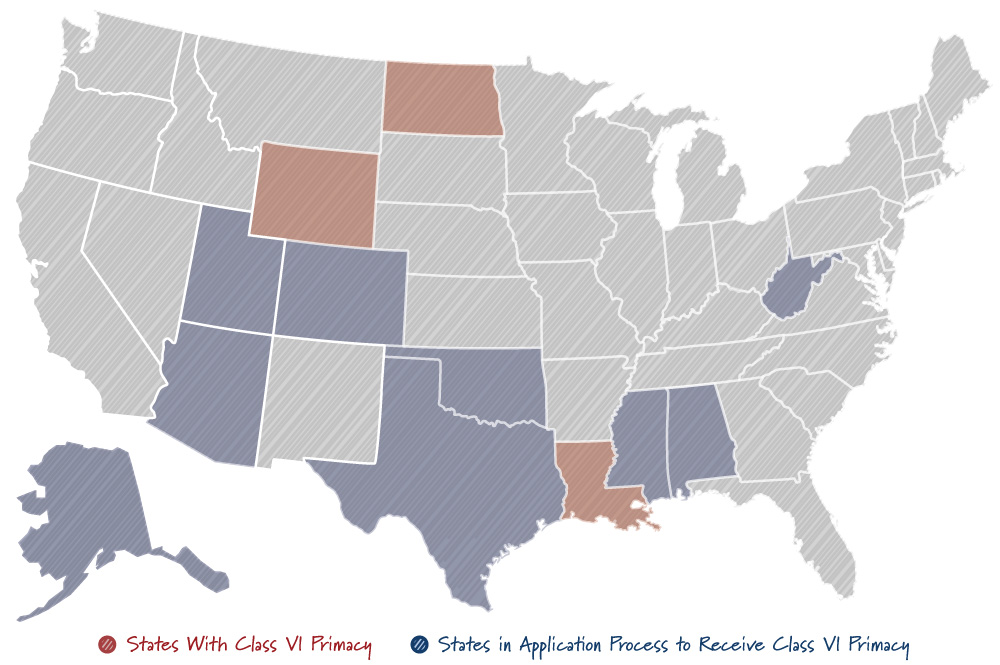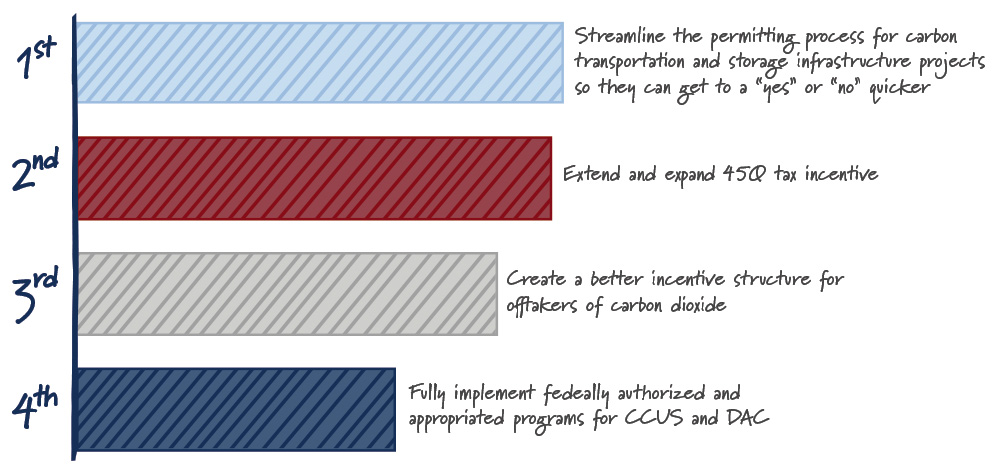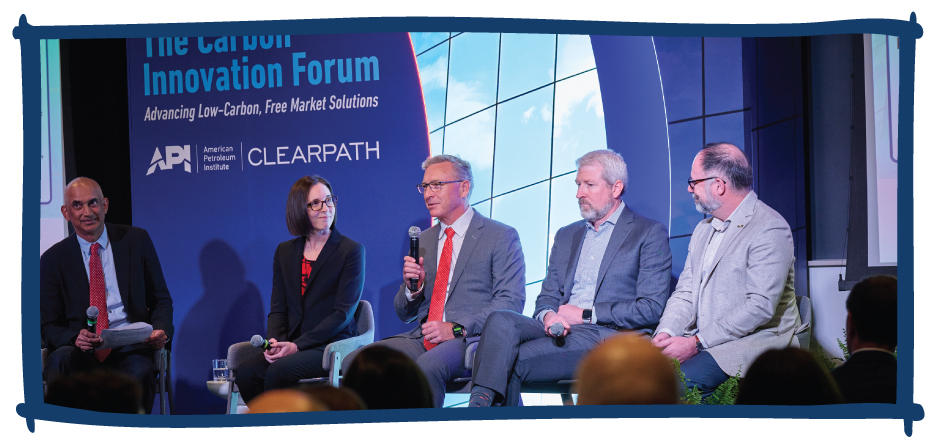Posted on September 26, 2024 by Kelsey Grant
For the third consecutive year, ClearPath partnered with the American Petroleum Institute (API) at New York Climate Week showcasing the cutting-edge clean technologies needed to reduce energy emissions across the U.S. economy. With the expertise and engineering know-how needed for clean energy innovation and deployment, the oil and gas industry is seizing the opportunity to lead emissions reductions at a global scale.
The Carbon Innovation Forum convened senior government officials, energy executives, project developers, technology startups, investors and thought leaders. The forum focused on creating market demand for low-carbon solutions, such as carbon capture utilization and storage (CCUS), carbon dioxide removal (CDR), low-carbon materials like hydrogen and concrete, and the need for streamlined permitting to unlock energy infrastructure build-out.

From Left to Right: ClearPath CEO Jeremy Harrell; DOE Deputy Under Secretary Leslie Biddle
The world is using more energy than ever before, and with new technologies like artificial intelligence (AI) and advanced computing, demand for clean, reliable power is set to soar. In 2020, the information and communication technology sector, including data centers, networks and user devices, consumed about 915 terawatt hours of electricity, which is four to six percent of global electricity that year. Electricity consumption from data centers, AI, and the cryptocurrency sector is projected to double by 2026.
As global demand for clean, affordable and reliable energy continues to grow, so does the opportunity and need for American energy leadership. We know America’s lawmakers and energy producers are up to the task. With continued innovation, American-produced products, including natural gas will facilitate lower emissions and bolster global energy security. A great example of this is liquefied natural gas (LNG). Thanks to its abundant supply of natural gas and novel technology innovation, the U.S. is the largest producer of this valuable resource and exporter of LNG in the world.
The U.S. is also a leader in the research and development (R&D) of key low-carbon technologies like CCUS, direct air capture (DAC), and hydrogen. The R&D was catalyzed by the Energy Act of 2020 and the bipartisan Infrastructure Investment and Jobs Act (IIJA) of 2021, which infused nearly $12 billion into carbon management programs and $8 billion for Regional Clean Hydrogen Hubs. These policy wins will support the U.S. energy sector as a global leader in clean energy and technology deployment.
Natural gas, CCUS, DAC, hydrogen, methane monitoring and nuclear are all needed to achieve deep decarbonization in various sectors, such as manufacturing and electricity generation. According to the Intergovernmental Panel on Climate Change (IPCC), for any low-carbon scenario, we need every tool in our toolbox to meaningfully reduce emissions across the economy.
Status of Class VI Primacy in the U.S.

States with Class VI primacy have a track record of permitting carbon dioxide sequestration sites years faster than the EPA.
CCUS has the potential to provide 14 percent of the global emissions reductions required by 2050, but the current capture capacity of operational projects is a fraction of what is needed. Similarly, CDR solutions are managing just shy of 100 thousand tons of carbon – accounting for only 0.001 percent of carbon removal required. With around 200 CCUS projects in various stages of development, around 150 clean hydrogen projects under development and two major DAC facilities in operation, innovators have begun demonstrating these technologies, and the rapid scale-up of these clean energy projects is the next step. To ensure the successful commercialization of these technologies and reach net zero by 2050, modernized permitting, demand-pull mechanisms, predictable, growth-oriented markets, and public-private collaboration are crucial.
CCUS can provide 14% of the Global emissions reductions needed by 2050 and is critical
for reducing emissions in difficult-to-decarbonize sectors. What’s needed to achieve this?

Participants at the forum voted permitting to be the top policy opportunity to generate demand and scale up CCUS projects more rapidly.
As CCUS and DAC move along the deployment curve, supporting infrastructure will be needed to further deploy and commercialize these technologies. This includes developing carbon storage sites for the permanent storage of carbon dioxide in geologic formations and the build-out of pipeline infrastructure – a vital link in the carbon management value chain. Highlighted during the Carbon Innovation Forum, eliminating red tape and streamlining permitting are critical and will help give project developers the predictability they need to get steel in the ground.
Economy-wide decarbonization will also require increased demand for low-carbon products like cement, steel, and chemicals, and CDR solutions. This event emphasized how new and existing demand-side mechanisms can play an important role in promoting the scale-up of these markets.
America’s largest energy producers, utilities, agriculture companies, financial institutions and other leaders are integrating a suite of clean technologies into their long-term business strategies. To seize this low-carbon opportunity and leverage America’s energy advantage, the Carbon Innovation Forum underscored the importance of building our energy infrastructure and deploying policy tools that incentivize the scale-up of low-carbon solutions on a global scale.

From Left to Right: Arjun Murti; Molly Laegeler; James Schaefer; Andrew Stinson; and Mark Gebbia
Thanks to our speakers: Rostin Behnam, Chairman, Commodity Futures Trading Commission (CFTC); Leslie Biddle, Deputy Under Secretary for Commercialization and Finance, U.S. Department of Energy; Marisa Buchanan, Senior Vice President – Low Carbon Solutions, bp trading & shipping; Kelly Coppola, Upstream Unconventional Issues and Advocacy Manager, ExxonMobil; Kerry Duggan, Founder and CEO, SustainabiliD; Fredrik Ekström, Chairman, Nasdaq Stockholm and Puro.earth; Allister Furey, CEO and Co-Founder, Sylvera; Mark Gebbia, Vice President for Environmental and Permitting, Williams; Leia Guccione, Managing Director, RMI/Hydrogen Demand Initiative (H2DI); Amy Harder, Executive Editor, Cipher News; Jeremy Harrell, CEO, ClearPath; Michael Johnson, Vice Chairman of Investment Banking, J.P. Morgan; Molly Laegeler, Vice President of Strategy & Sustainability, Chevron; Michael Leitch, Senior Technical Lead, XPRIZE Carbon Removal; Sonrisa Lucero, Special Advisor for Stakeholder Engagement, U.S. Department of Energy; Joseph Majkut, Director of Energy Security and Climate Change Program, Center for Strategic and International Studies; Arjun Murti, Partner, Veriten; Aaron Padilla, Vice President of Corporate Policy, API; James Schaefer, Senior Managing Director, Guggenheim Securities Investment Banking; and Andrew Stinson, Managing Director – Head of Americas ESG Funding Solutions, Bank of America.
Please note this event adhered to Chatham House Rule.
